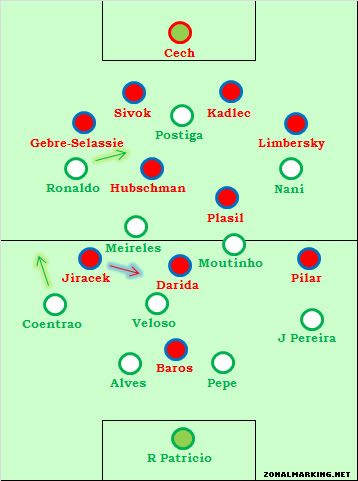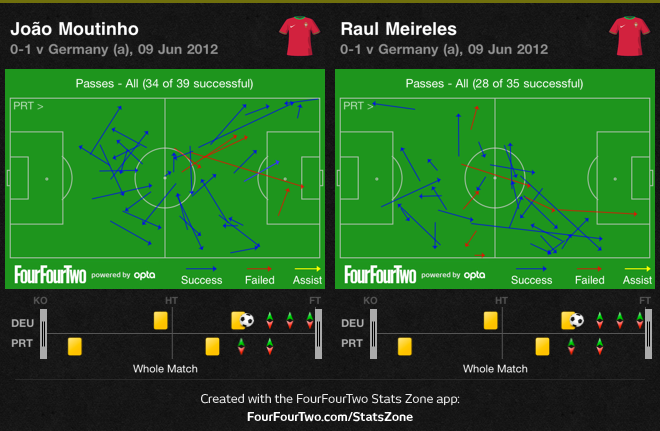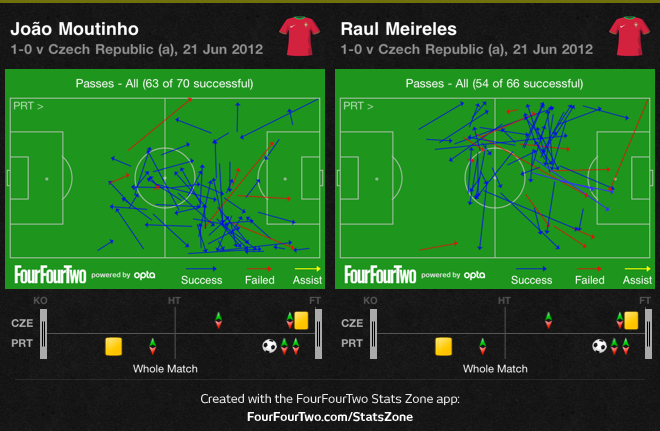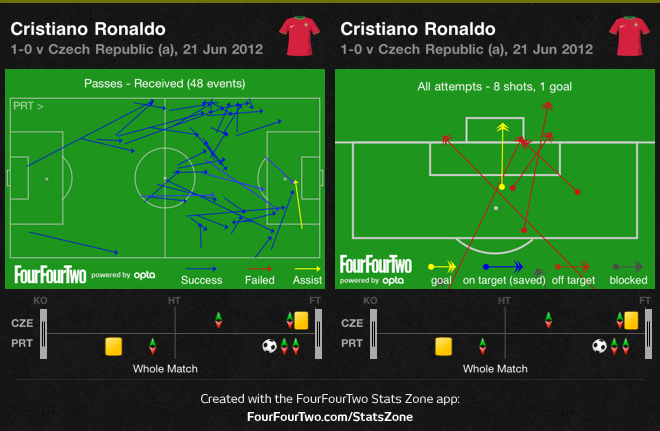|
|
本帖最后由 thewall 于 2012-6-22 10:22 编辑
Portugal 1-0 Czech Republic: Ronaldo a constant threat and eventually gets the winner
June 21, 2012

The first half line-ups, though Ronaldo drifted around and Nani spent some time on the left
Cristiano Ronaldo was a greater goalscoring threat than the Czech side put together, as Portugal narrowly won a game that should have been safe much earlier.
Paulo Bento named an unchanged side again – he’s played this XI in Portugal’s last six competitive games, four at the Euros, two in the play-offs against Bosnia.
Michael Bilek was without Tomas Rosicky again, and used Vladimir Darida rather than Daniel Kolar in Rosicky’s attacking midfield role.
This was a one-sided game, with Portugal superior all over the pitch.
Shapes and overloads
The game settled down into a fairly predictable pattern and shape, with a 4-3-3 against a 4-2-3-1. Each midfielder had a specific opponent to track and the battles on the wings were clear 1 v 1s. The slight exceptions involved each side’s deepest midfielder occasionally becoming overloaded. Veloso played slightly left-of-centre and became distracted by Petr Jiracek’s drifts in from the flank, which forced him to leave Darida a couple of times. Darida is clearly an intelligent player and his positioning and movement caused Veloso some difficulties, but the youngsters didn’t have the necessary skill on the ball to influence the game.
At the other end, Tomas Hubschman played right-of-centre, trying to guard the zone Ronaldo was moving into. That meant he was concerned with a wide player rather than an opposition midfielder, and Portugal’s midfield runners could move into that zone unchecked.
Battle down the flank
The expected battle was down the Ronaldo flank, where Theodor Gebre-Selassie should have been braver with his positioning. He was (understandably but frustratingly) cautious with his positioning, only moving in advance of Ronaldo a couple of times. He focused much more on his defensive duties than in his previous three games. Further up, Jiracek marked Fabio Coentrao well.
Ronaldo had actually spent much of the first 20 minutes in more central positions, with Nani popping up on the left, though Portugal didn’t look particularly good with this system, and it coincided with their weakest spell of the game. When they moved to a natural 4-3-3, they were the better side by far.
A major feature of the first half was how tightly the Czech full-backs tried to stick to the Portuguese wingers when Portugal moved forward with the ball. Gebre-Selassie ended up in central positions a couple of times, practically in front of his centre-backs. Jiracek made sure Coentrao didn’t exploit the space too readily. On the other wing, Nani moved into deeper positions on the right, with David Limbersky moving up the pitch. Joao Pereira didn’t overlap particularly impressively.
The Portuguese midfield has changed from the opening game of the tournament. Here, Raul Meireles was to the left, Joao Moutinho to the right. See the change from the opening game against Germany:


This didn’t have a particularly big influence on the game – it meant the two midfield creators, Plasil and Moutinho, were against each other, and that Meireles had space ahead of him to break into, although his decision-making was often poor.
The Czechs struggled at attacking transitions – their creative players simply couldn’t get the ball because of some aimless balls down the pitch. One clearance from Limbersy, a flick-up-and-volley to absolutely no-one, summed it up.
Helder Postiga went off injured, with Hugo Almeida replacing him. This meant a more static central striker upfront for Portugal, though Almedia did reasonably well by occupying both centre-backs and creating space for others.
Midfield runners
Little changed after half-time, but Portugal made more of an effort to get midfielders forward into the final third. Whether it was by design or accident, their first chance of the second half demonstrated where the Czechs were logically going to be vulnerable. With the full-backs sticking tight to the Portuguese wingers, Portugal could get extra players into space in those wide zones. That’s what Meireles did straight away, moving to the left wingas Gebre-Selassie moved inside with Ronaldo, and Meireles crossed for a good near post chance for Almeida, who headed over. Portugal needed more of this thrust from midfield.
Bilek realised that Darida was struggling to get involved in the game, so withdrew him and pushed Jiracek inside, introducing Jan Rezek on the right. This didn’t really help – it was a slightly more direct approach, and more suited to counter-attacking, but aside from one Pilar solo run, the Czech Republic created little.
Ronaldo
The game became increasingly about Ronaldo. He’d hit the post with a brilliant turn and shot late in the first half, then hit the post from a long-range free-kick after the break. He largely abandoned his movements into central playmaking positions, choosing either to get the ball on the wing, or move directly into the box for crosses. This encouraged the midfield players forward, and both Meireles and Moutinho had shots from just outside the box, with the latter more impressive than the former.

Ronaldo’s winner had been coming. Portugal were spreading the ball wide to Nani, who had a couple of opportunities to cross in the minutes leading up to the goal. Sure enough, it was Moutinho storming forward from midfield unchecked into a wide zone – just like Meireles at the start of the second half – that resulted in the breakthrough, and Ronaldo’s excellent run across the face of Gebre-Selassie was the other key component. The expected team won, and the expected player scored the crucial goal.
Conclusion
This was a very unimpressive performance from Bilek’s side – they didn’t defend well, counter effectively or hold onto the ball for long periods. Their gameplan was unclear. Realistically, they’re simply not a good side. They overachieved by making it through Group A, so Bilek can be satisfied with his side’s performance, but further progression was unlikely.
This was probably Portugal’s best display of the competition, as their first clean sheet was combined with constant chance creation. They need better decision-making in the final third, and the midfield triangle will have to be more efficient against their semi-final opponents, but if Ronaldo is this visible in future matches, they have a realistic chance of winning the competition. |
|

